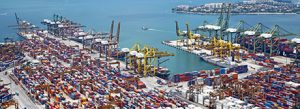As the COVID-19 pandemic crisis continues and deepens globally, shipping and freight continue to be the life blood for many nations. Beyond mere economics and trade, it is shipping and freight that delivers food and medical supplies to much of the world, every month. Source: IndustryEdge
All eyes were turned to China as the pandemic commenced, and so too have they been glued for what might be the first fluttering signs of recovery, almost five months, since the novel coronavirus first began to spread in Wuhan.
Official Chinese data shows shipments of containers were down 19.8% in February, compared with a year earlier, but the Wall Street Journal reported on 19 March that Chinese ports were again moving significant numbers of containers, many of which have been stranded since early January.
The flow-on effects of the supply-chain disruption have included less goods being shipped from China (we see the impact in face mask and medical gown shortages for instance). That has meant a shortage of containers in many locations and has stalled exports.
In turn, that is directly impacting imports into countries including Australia and New Zealand. It is, for instance, one of the main reasons why paper merchants are reporting an additional three to four-week delay in orders and deliveries of paper and paperboard from Europe and Asia.
The logistics issues do not end with China recommencing shipments however, it is entirely feasible for containers landed in Australia and New Zealand to be uncollected for long periods due to what are ever-tightening movement restrictions.
Even more dramatic would be the inability of vessels to offload their cargoes. With situations changing daily, it is an act of faith to load a vessel for a three-week journey right now. There is some optimism from shipping companies, with expectations expressed as a ‘return to normal in two months.
Right now, that seems a distant prospect. One estimate, based on January and February’s movements alone, suggests container volumes will be down around 10% in 2020 – about 17 million 20ft equivalent units (TEUs). Even that estimate assumes trade will return to normal and supply-chains will be back in systematic order before year’s end.








